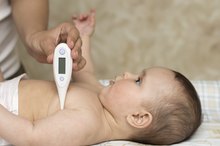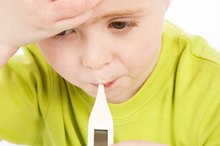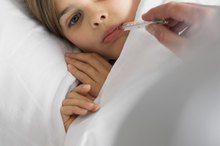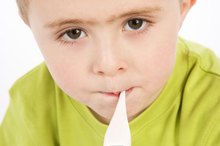Is a Kid Still Sick When a Fever Breaks?
Watching your child deal with an illness is always difficult, but her fever breaking is often a sign she's on the way to recovery. As her temperature starts to go down, she should start to feel better, but she won't be completely healthy right away. Be on the lookout for signs that indicate her illness is getting worse, and don't hesitate to call the pediatrician if you're concerned.
Fever Basics
A fever occurs when the body has to work harder than normal in order to fight off illness. The human average is 98.6 degrees Fahrenheit, but your child may typically run a degree warmer or colder than this. According to Dr. Barbara Huggins, a child has a fever if her rectal temperature is 100.4 degrees or higher; rectal temperatures tend to run around 1 degree warmer than oral temperatures. When the fever "breaks," her temperature should start dropping back to a normal range as her body starts cooling off. She may start sweating at this point.
- A fever occurs when the body has to work harder than normal in order to fight off illness.
- According to Dr. Barbara Huggins, a child has a fever if her rectal temperature is 100.4 degrees or higher; rectal temperatures tend to run around 1 degree warmer than oral temperatures.
Fever Causes
A 5 Year Old With a Fever & No Other Symptoms
Learn More
Fevers can accompany everything from the common cold to life-threatening conditions such as meningitis. If she simply has sniffles and a sore throat, you can usually treat her cold at home with rest 2. If she's achy and has vomiting and diarrhea along with a fever, she may have the flu and should see the doctor. In a child between 6 months and 3 years old, fever can be caused by a common viral infection called roseola.
- Fevers can accompany everything from the common cold to life-threatening conditions such as meningitis.
- If she's achy and has vomiting and diarrhea along with a fever, she may have the flu and should see the doctor.
GIving Comfort
Regardless of the fever's cause, you can't cause it to break, but you can keep your child comfortable. Encourage her to drink plenty of liquids, and don't cover her in heavy clothing and blankets. Give her some acetaminophen or ibuprofen, with the doctor's permission.
Signs of Improvement
When Does a Fever Become Dangerous for a Baby?
Learn More
When the fever is caused by the flu or a cold, your child should start to feel better once the fever breaks. It may take a few days for her to fully recover from a cold, or up to a week until she recovers from the flu, but her symptoms should start to decrease. If your child has roseola, the rash won't begin until after the fever breaks. You'll notice a pink rash, with flat or slightly raised dots. Roseola should clear up on its own after a few days, though your doctor may recommend you give your child over-the-counter pain relievers. Keep her home for a few days, as the rash is contagious.
- When the fever is caused by the flu or a cold, your child should start to feel better once the fever breaks.
- If your child has roseola, the rash won't begin until after the fever breaks.
Complications
In infants and toddlers, even a low-grade fever can be a sign of a serious problem 2. The American Academy of Pediatrics recommends calling the pediatrician when a child younger than 4 months develops even a low-grade fever. You must also call the doctor if your child doesn't start feeling any better or seems listless after her fever breaks, or if her fever lasts longer than three days. If it any time during a fever she has any breathing difficulties, confusion or has trouble staying alert, call the doctor right away since these are all signs of serious medical problems.
- In infants and toddlers, even a low-grade fever can be a sign of a serious problem 2.
- The American Academy of Pediatrics recommends calling the pediatrician when a child younger than 4 months develops even a low-grade fever.
Related Articles
References
- MayoClinic.com: Fever: First Aid
- BabyCenter: How Can I Tell if My Toddler Has a Cold or Something More Serious?
- MayoClinic.com: Roseola: Definition
- HealthyChildren.org: Fever Without Fear
- Sullivan JE, Farrar HC. Fever and antipyretic use in children. Pediatrics. 2011;127(3):580-7. doi:10.1542/peds.2010-3852
- Chapman J, Arnold JK. Reye syndrome. In: StatPearls. Updated January 17, 2019.
- El-Radhi AS. Fever management: evidence vs current practice. World J Clin Pediatr. 2012;1(4):29-33. doi:10.5409/wjcp.v1.i4.29
Writer Bio
Cooking, travel and parenting are three of Kathryn Walsh's passions. She makes chicken nuggets during days nannying, whips up vegetarian feasts at night and road trips on weekends. Her work has appeared to The Syracuse Post-Standard and insider magazine. Walsh received a master's degree in journalism from Syracuse University.









